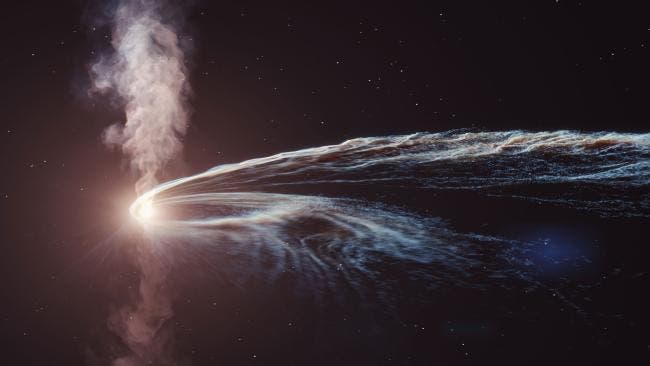Space can be a very strange place. According to new research, black holes, the most destructive and extreme objects we’ve ever seen, also burp after a hearty meal.

Back in October 2018, a bright flash brought astronomers’ attention to a corner of the night sky. Its source was pinpointed at 665 million light years away from our planet, where a small star wandered too close to a black hole — the flash was its electromagnetic death throes as the star was being ripped to shreds and consumed.
Tragic for that little star, but not an uncommon sight for astronomers. So we followed as the event unfurled and then turned our telescopes elsewhere.
But some four years after the stellar slaughter, the same region of space has sent us yet another flash. And this time, astronomers say, the black hole hasn’t eaten anything new. This time, astronomers really were met with something they hadn’t seen before.
In-n-Out
“This caught us completely by surprise — no one has ever seen anything like this before,” says Yvette Cendes, a research associate at the Harvard & Smithsonian Center for Astrophysics, and lead author of a new study analyzing the phenomenon.
The recordings suggest that the black hole is now releasing matter at incredible velocities, around half the speed of light. That matter, the team believes, is the remnant of the black hole’s last meal, the tiny star we were watching it consume in October 2018. It’s not very dissimilar to the body “burping” after a meal, according to Cendes. The findings offer a unique opportunity to help researchers better understand how black holes consume matter, the authors explain.
The unusual radio outburst was spotted while the team was revisiting tidal disruption events (TDEs) which occurred over the last several years. TDEs take place when stars get too close to black holes and become ‘spaghettified‘.
The team used data from the Very Large Array (VLA), the ALMA Observatory in Chile, MeerKAT in South Africa, the Australian Telescope Compact Array in Australia, and the Chandra X-Ray Observatory and the Neil Gehrels Swift Observatory in space in New Mexico in New Mexico to study the event, dubbed AT2018hyz.
“We applied for Director’s Discretionary Time on multiple telescopes, which is when you find something so unexpected, you can’t wait for the normal cycle of telescope proposals to observe it,” Cendes explains. “All the applications were immediately accepted.”
“We have been studying TDEs with radio telescopes for more than a decade, and we sometimes find they shine in radio waves as they spew out material while the star is first being consumed by the black hole,” says Edo Berger, professor of astronomy at Harvard University and the CfA, and co-author on the new study. “But in AT2018hyz there was radio silence for the first three years, and now it’s dramatically lit up to become one of the most radio luminous TDEs ever observed.”
Co-author Sebastian Gomez, a postdoctoral fellow at the Space Telescope Science Institute, explains that AT2018hyz was considered “unremarkable” back in 2018 when it was first viewed using optical telescopes. Such events are quite bright in visible light, which is produced by stellar material being spun around very fast around the black hole and heating up to the point of incandescence.
The team monitored it for several months until things wound down to a halt, and then trained their telescopes elsewhere.
At the time, Gomez was working on his doctoral dissertation with Berger and was busy using theoretical models to calculate the mass of the star being torn apart by the black hole — which they determined was only around one-tenth of the mass of the Sun.
“We monitored AT2018hyz in visible light for several months until it faded away, and then set it out of our minds,” Gomez says.
We do know that spaghettified material can be flung back into space after a black hole ‘feeds’, as some of the former star is spun so fast that it can escape the immense gravity well of its captor. But these ‘outflows’ of matter normally develop very quickly after a TDE event. In this case, seeing one take place years after a star was consumed was very confusing to astronomers. This was the first time such a long delay between feeding and outflow has ever been seen.
The fact that this outflow was so delayed means that it behaved differently than others of its kind. The matter being ejected from the black hole is traveling at around 50% of the speed of light; most TDE outflows only reach around 10% of the speed of light.
“The next step is to explore whether this actually happens more regularly and we have simply not been looking at TDEs late enough in their evolution,” Berger says.
The paper “A Mildly Relativistic Outflow Launched Two Years after Disruption in Tidal Disruption Event AT2018hyz” has been published in The Astrophysical Journal.






